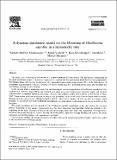| dc.contributor.author | Jiménez, Ricardo | |
| dc.contributor.author | Verreth, Johan | |
| dc.contributor.author | Steenbergen, Kees | |
| dc.contributor.author | Moed, Jan | |
| dc.contributor.author | Machiels, Marcel | |
| dc.date.accessioned | 2020-09-29T22:25:14Z | |
| dc.date.available | 2020-09-29T22:25:14Z | |
| dc.date.issued | 1995-01-15 | |
| dc.identifier.other | SSDI 0304-3800(94)00114-W | |
| dc.identifier.uri | http://hdl.handle.net/11056/18264 | |
| dc.description.abstract | The occurrence of phytoplankton blooms is a common problem in water bodies. The quantitative description of the algal population growth is of primary importance to understand the mechanisms which lead to these phytoplankton blooms, hence also for the development of a successful water-quality management. Due to the high degree of complexity of phytoplankton blooms, dynamic simulation models may be a powerful tool to study and elucidate the mechanisms leading to these blooms. In the present study, a simulation model for the blooming of a natural population of Oscillatoria agardhii in Lake Vechten (lat. 52°04′N, long. 5°05′E, the Netherlands) using measured temperature, filament length and nutrient concentrations as external drives, is presented. The lake was sampled weekly from January to the middle of May, 1992. Temperature, nutrient concentration (nitrate and phosphate in the water) and filament length were recorded. Because cell size was constant, filament length could be converted to number of cells per litre to estimate algal biomass. To implement the model additional information, e.g. some algal growth parameters, was obtained from the literature. The model simulated well the growth of the Oscillatoria agardhii population in the lake during the research period. According to the model, temperature was the most important rate-limitating factor for growth at the beginning of the year. Nutrient limitation became increasingly important while the importance of temperature limitation decreased during the season. During the whole period, light was strongly limiting and became the most important rate-limiting factor in the second week of April. Via sensitivity analysis, the model showed to be highly affected by temperature-related factors, and it was useful in the identification of research needs. | es_ES |
| dc.description.abstract | La aparición de floraciones de fitoplancton es un problema común en los cuerpos de agua. La descripción cuantitativa del crecimiento de la población de algas es de primordial importancia para comprender los mecanismos que conducen a estas floraciones de fitoplancton y, por lo tanto, también para el desarrollo de una gestión exitosa de la calidad del agua. Debido al alto grado de complejidad de las floraciones de fitoplancton, los modelos de simulación dinámica pueden ser una herramienta poderosa para estudiar y dilucidar los mecanismos que conducen a estas floraciones. En el presente estudio, un modelo de simulación para la floración de una población natural de Oscillatoria agardhii en el lago Vechten (lat. 52 ° 04′N, long. 5 ° 05′E, Países Bajos) utilizando la temperatura medida, la longitud del filamento y las concentraciones de nutrientes. como unidades externas, se presenta. Se tomaron muestras del lago semanalmente desde enero hasta mediados de mayo de 1992. Se registraron la temperatura, la concentración de nutrientes (nitrato y fosfato en el agua) y la longitud del filamento. Debido a que el tamaño de las células era constante, la longitud del filamento se podía convertir en número de células por litro para estimar la biomasa de algas. Para implementar el modelo información adicional, p. Ej. algunos parámetros de crecimiento de algas, se obtuvo de la literatura. El modelo simuló bien el crecimiento de la población de Oscillatoria agardhii en el lago durante el período de investigación. Según el modelo, la temperatura fue el factor limitante de la tasa de crecimiento más importante a principios de año. La limitación de nutrientes se volvió cada vez más importante, mientras que la importancia de la limitación de la temperatura disminuyó durante la temporada. Durante todo el período, la luz fue fuertemente limitante y se convirtió en el factor limitante de velocidad más importante en la segunda semana de abril. A través del análisis de sensibilidad, el modelo demostró estar muy afectado por factores relacionados con la temperatura y fue útil para identificar las necesidades de investigación. | es_ES |
| dc.description.sponsorship | Department of Fish Culture and Fisheries, Wageningen Agricultural University, The Netherlands | es_ES |
| dc.description.sponsorship | Universidad Nacional, Costa Rica | es_ES |
| dc.language.iso | eng | es_ES |
| dc.publisher | Elsevier | es_ES |
| dc.rights | Acceso abierto | es_ES |
| dc.source | Ecological modelling vol.78 no.1-2 17-24 1995 | es_ES |
| dc.subject | PHYTOPLANKTON | es_ES |
| dc.subject | POPULATION DYNAMICS | es_ES |
| dc.subject | OSCILLATORIA AGARDHII | es_ES |
| dc.subject | MODELLING | es_ES |
| dc.subject | MÉTODOS DE SIMULACIÓN | es_ES |
| dc.subject | FITOPLANCTON | es_ES |
| dc.subject | ALGAS | es_ES |
| dc.title | A dynamic simulation model for the blooming of Oscillatoria agardhii in a monomictic lake | es_ES |
| dc.type | http://purl.org/coar/resource_type/c_6501 | es_ES |
| dc.description.procedence | Escuela de Ciencias Biológicas | es_ES |
| dc.identifier.doi | doi.org/10.1016/0304-3800(94)00114-W | |

